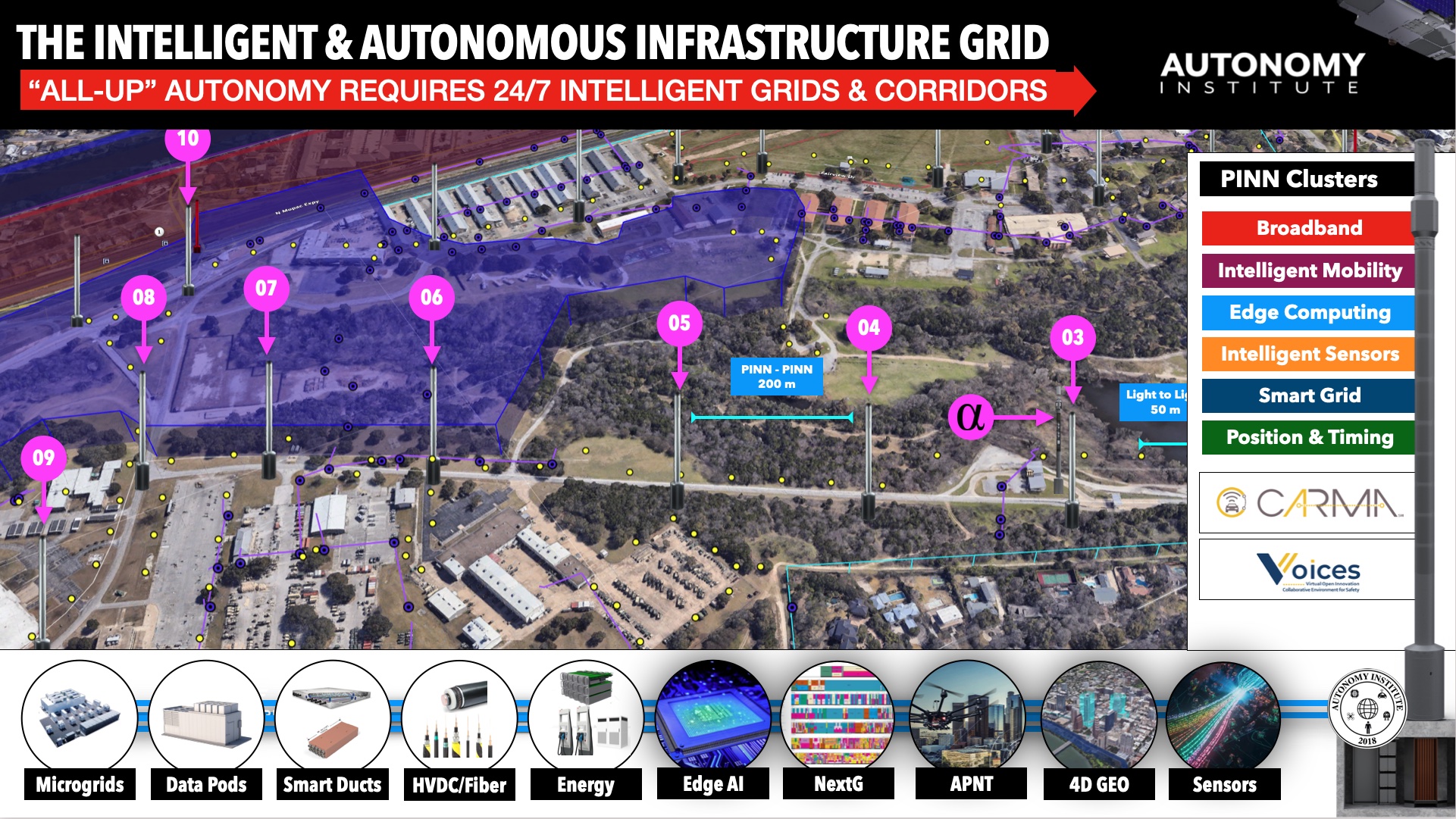TMD Camp Mabry Intelligent Infrastructure GRID
TMD Camp Mabry is supporting the first Intelligent Infrastructure Grid of PINNs. They will help advance the use of intelligent and autonomous systems for protecting our communities and providing resilience in Texas as well as the Nation.
Public-Private Partnerships will accelerate our national priorities and how Intelligent Infrastructure enables Resilient Cities & Bases. The Autonomy Institute will be providing the best intelligent and automated platforms to the brave men and women that protect our country.
INDUSTRY 4.0 – 21st-Century Intelligent Infrastructure
-
National Priority to meet the demand for NextG, Edge, ITS, APNT, Grid
-
Mabry will be the “Genesis” of national edge deployments.
-
Lab will be the accelerator to $100+ million P3 Programs
-
Create Industry 4.0 jobs, economic impact, and national leadership
Views from Camp Mabry
Digital twins are a virtual representation of a city, port, highway, vehicle, or object, constructed only by a digital database. A digital twin could vary in representation from simple localization metadata, to high fidelity visual and dynamic modeling. This means, twins can evolve over time, becoming more and more representative of the real-world counterpart. Realtime updates, state changes, and abnormality alerts are all simplistic use cases for digital twins.
Supporting the development of autonomous systems within a city will require zones of operations to be defined. These zones will leverage easements within cities to support autonomous cars, trucks, shuttles, rovers, drones and other vehicles that provide sustainable value to the city’s operations. In the initial phase the focus will also provide a tremendous amount of data to Universities and Federal testing centers to define the critical standards needed to support autonomy.
In order to support the development of drones, avigation easements will be defined. Avigation easements is an easement or right overflight in the airspace above or in the vicinity of a particular property. It also includes the conditions on the impact overflight may have from the lawful operation of drones in such airspace.
The creation, monitoring and management of avigation easements allow for safe and secure deployment of small drones. These avigation easements allow a defined corridor for all CONOPS within a private or low-use public utility easement to dramatically limit the potential of flying over people. The small drones will fly at low elevations around 10-50’ above infrastructure easements on their way to mission performance. AMZs will leverage the Autonomous Infrastructure. All drones deployed within the corridor will be connected using a RAN network providing <50ms response (20 Hertz). Each drone will have specific fail-safe algorithms to assure safe return to depot locations or designated safe-zone rally points.
The PINN Clusters are the 21st-century equivalent to interstate highways. Digital Edge Infrastructure is as tactical as roads are to cars. Similar to the military convoy trying to drive across the country in the early 1900s, we were focusing on bigger wheels, better suspension, bigger engines until Eisenhower finally said, “We need to build interstate highways.” We find ourselves in the similar situation; everyone is focused on the vehicle, the device, the digital service, the drone, the aircraft rather than realizing this is a digital and physical infrastructure challenge. Vehicles required roads, and the Internet required backbone networks. Intelligent and Autonomous systems require a dense, secure, and resilient “Digital Edge Infrastructure.”
We have announced the Public Infrastructure Network Node (PINN) rollout at Camp Mabry, we are collaborating with strategic partners. The plan is to have systems up and running by 3rd qtr. EDJX is developing the Internet of Military Things from base to battlefield. “The goal is to reduce latency and increase the effective throughput of content for warfighters at the tactical edge, which will significantly enhance the tactical effectiveness of the warfighter by providing the information they need, when they need it.” – DARPA
The Grid at Camp Mabry is a sandbox for an array of hardware, software, ISVs that can integrate their solutions with the EdjOS for the tactical warfighter IoMT edge. EDJX is the network mesh on which these applications, hardware and sensor solutions can sit and live. The Warfighter Tactical Edge enables the Internet of Military Things. The will be an incredibly powerful platform and at a location a few miles from the Software Factory.
Army Futures Command Software Factory could be the first in the nation to have a “Programming the Intelligent Edge” initiative. Edge Computing is the focus of commercial industry since it combined low-latency networks, IoT devices, high performance compute, and massive data flows into the hands of programmers. DoD should be very active in this new platform.
TMD Camp Mabry GRID Use Cases
-
Energy Transmission
-
Building Inspections
-
Infrastructure Inspections
-
Routine Security
-
Water Quality of Detention Ponds
-
Examples
-
Commercial Construction Inspections
-
Bridge and Overpass Analysis
-
Road Inspections
-
Solar Panel Inspections
-
Oil and Gas Infrastructure Inspection
-
Master Plan Modeling
-
Environmental Studies
-
Culvert Inspections
-
Site Inventory Inspection
-
Wildfire Tracking and Mitigation
-
Public Safety and Emergency
-
Situational Awareness
INTELLIGENT INFRASTRUCTURE DEPLOYMENT PLAN





























































